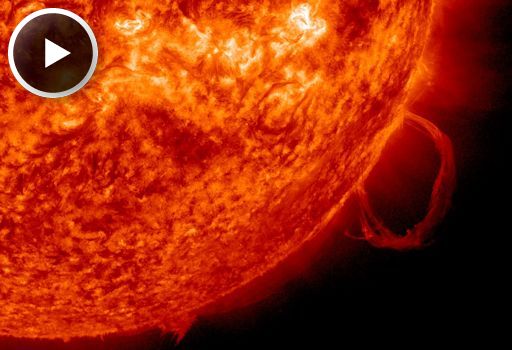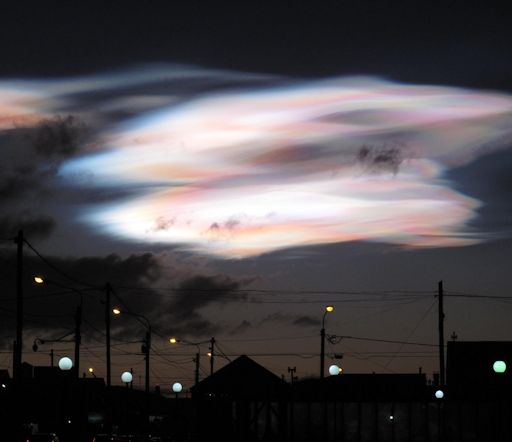When is the best time to see auroras? Where is the best place to go? And how do you photograph them? These questions and more are answered in a new book, Northern Lights - a Guide, by Pal Brekke & Fredrik Broms. | | |
PERSEID METEOR SHOWER: New research by NASA's Meteoroid Environment Office shows that one meteor shower produces more fireballs than any other--the Perseids. This year's Perseid peak is just around the corner on August 12-13. Get ready for fireballs.
ERUPTING MAGNETIC FILAMENTS: During the late hours of July 26th, two filaments of magnetism erupted on the sun. The first to blow was this loop on the sun's southwestern limb:

A second filament connecting sunspots AR1800 and AR1805 erupted shortly thereafter. Both blasts are captured in this movie, recorded by NASA's Solar Dynamics Observatory.
The explosions hurled coronal mass ejections (CMEs) into space: movie. One of them (the one propelled by the filament connecting AR1800 and AR1805) might be heading in the general direction of Earth. An analysis the CME's trajectory is in progress as more imagery becomes available. Aurora alerts: text, voice.
Realtime Space Weather Photo Gallery
NACREOUS CLOUDS OVER TIERRA DEL FUEGO: On July 24th, about an hour after sunset, Gerardo Connon of Rio Grande city in Tierra del Fuego, Argentina, walked outside and witnessed a rare display of nacreous clouds. The colorful apparition was as bright as the street lights in the city below:

These clouds, also known as "mother of pearl clouds," form in the stratosphere far above the usual realm of weather. They are seldom seen, but when they are, the reports usually come from high-northern parts of our planet. This apparition over Tierra del Fuego was unusual indeed.
Atmospheric optics expert Les Cowley explains the special conditions required to create such a cloud: "Take an unusually cold lower stratosphere (15-25km high), use some gravity waves generated by high winds and storms in the troposphere to stir in some water vapour, and -- voilà! You get these clouds made of tiny ice crystals shining after sunset with unforgettably bright iridescent colors."
"The very special conditions make nacreous clouds a rare, high-latitude phenomenon. Scandinavia, Iceland and northern Canada are favourite places to see them. Sightings in the southern hemisphere are even more rare because there is so little land far enough south except for Antarctica."
Realtime Aurora Photo Gallery
Realtime Noctilucent Cloud Photo Gallery
[previous years: 2003, 2004, 2005, 2006, 2007, 2008, 2009, 2011]
Realtime Comet Photo Gallery
Potentially Hazardous Asteroids (
PHAs) are space rocks larger than approximately 100m that can come closer to Earth than 0.05 AU. None of the known PHAs is on a collision course with our planet, although astronomers are finding
new ones all the time.
On July 27, 2013 there were potentially hazardous asteroids.
Recent & Upcoming Earth-asteroid encounters: | Asteroid | Date(UT) | Miss Distance | Size |
| 2006 BL8 | Jul 26 | 9.3 LD | 48 m |
| 2003 DZ15 | Jul 30 | 9.1 LD | 159 m |
| 2005 WK4 | Aug 9 | 8.1 LD | 420 m |
| 1999 CF9 | Aug 23 | 24.7 LD | 1.1 km |
| 2002 JR9 | Aug 31 | 63.5 LD | 1.4 km |
| 1992 SL | Sep 23 | 70 LD | 1.1 km |
Notes: LD means "Lunar Distance." 1 LD = 384,401 km, the distance between Earth and the Moon. 1 LD also equals 0.00256 AU. MAG is the visual magnitude of the asteroid on the date of closest approach. | | The official U.S. government space weather bureau |
| | The first place to look for information about sundogs, pillars, rainbows and related phenomena. |
| | Researchers call it a "Hubble for the sun." SDO is the most advanced solar observatory ever. |
| | 3D views of the sun from NASA's Solar and Terrestrial Relations Observatory |
| | Realtime and archival images of the Sun from SOHO. |
| | from the NOAA Space Environment Center |
| | the underlying science of space weather |

